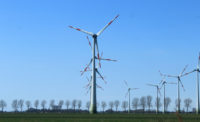The American Society of Safety Professionals (ASSP) has published the first U.S. industry consensus standard written specifically for the construction and demolition of wind turbines. ANSI/ASSP A10.21-2018 was approved in April by the American National Standards Institute (ANSI). ASSP is secretariat of the A10 Accredited Standards Committee.
Safety Requirements for Safe Construction and Demolition of Wind Generation/Turbine Facilities establishes minimum requirements for protecting workers involved in the construction and demolition of a utility-scale, land-based wind turbine, a device that converts the wind’s kinetic energy into electrical energy.
Collections of large turbines, known as wind farms, are a growing source of renewable energy that provide an alternative to fossil fuels. The production of wind energy has grown from 23,900 megawatts in 2001 to nearly 540,000 megawatts in 2017, and now accounts for 4 percent of the world’s electricity production. This global growth underscores the need for wind turbine construction and demolition to be conducted in a safe manner.
“Wind energy has unique challenges that were simply not adequately addressed in existing standards,” said Christopher Daniels, chair of the A10.21 subcommittee. “The new standard brings these challenges to light and identifies appropriate means for risk mitigation.”
Among the challenges are the remoteness of the work, turbine height, limited access and turbine manufacturer variables. The new standard sets requirements for site hazard identification and the equipment used, in addition to detailing steps employers must take during training to help prevent worker injuries and fatalities.
“A10.21 does more than communicate the requirements of the standard,” Daniels said. “It includes nearly a dozen appendixes that identify additional considerations for specific scopes of work found in wind projects.”
The standard calls for contractors to develop a site-specific plan that addresses safety concerns of working in a remote location, including lack of emergency response, unreliable communication networks and environmental issues such as weather and wildlife. Contractors must also evaluate wind turbine hazards such as unguarded moving parts and exposed electrical components. The standard contains requirements for cranes and rigging used during the construction process, and identifies qualifications for crane operators, riggers and signal workers.
To purchase the A10.21-2018 standard for wind turbine construction and demolition, visit ASSP’s online store.


